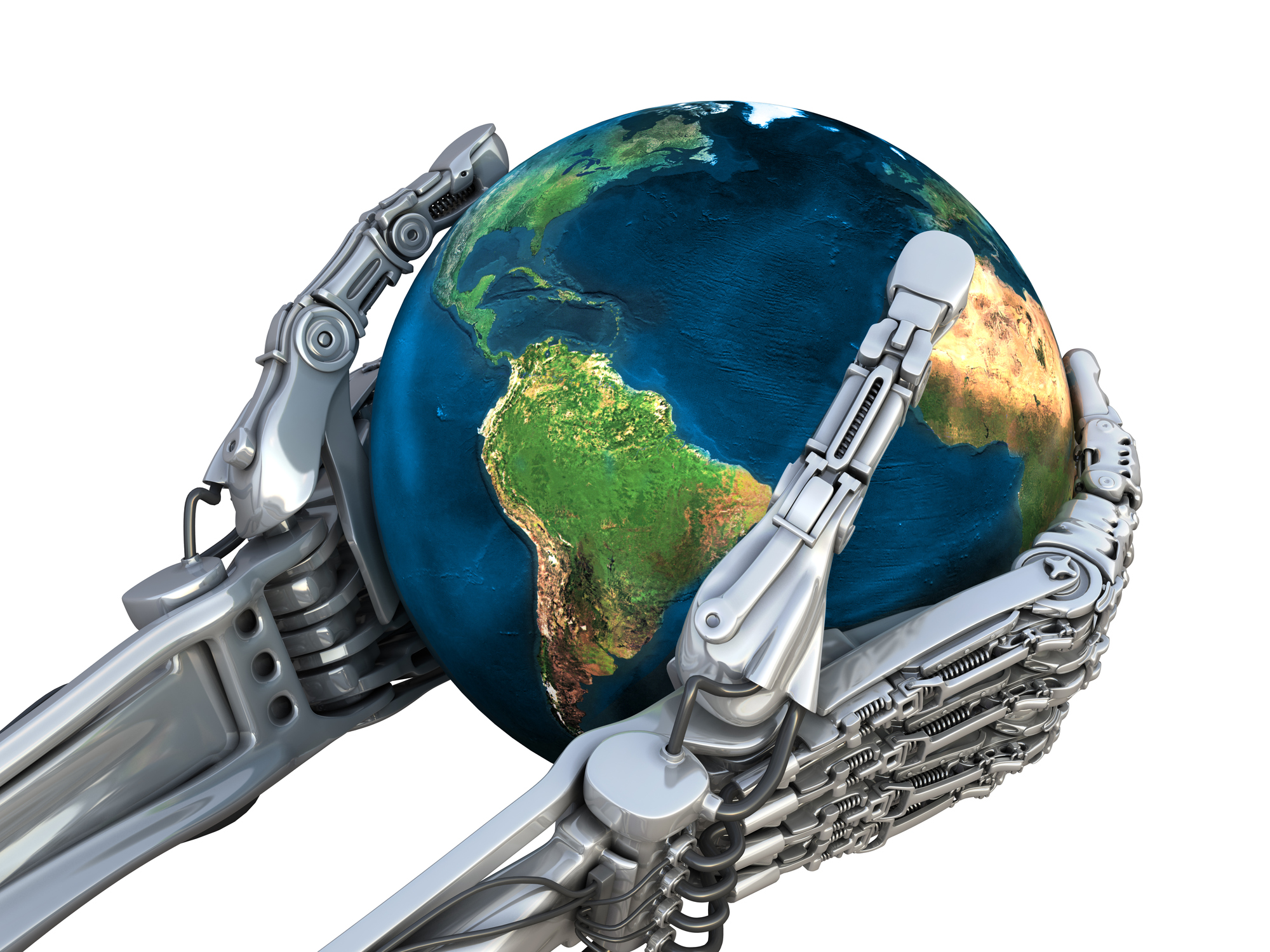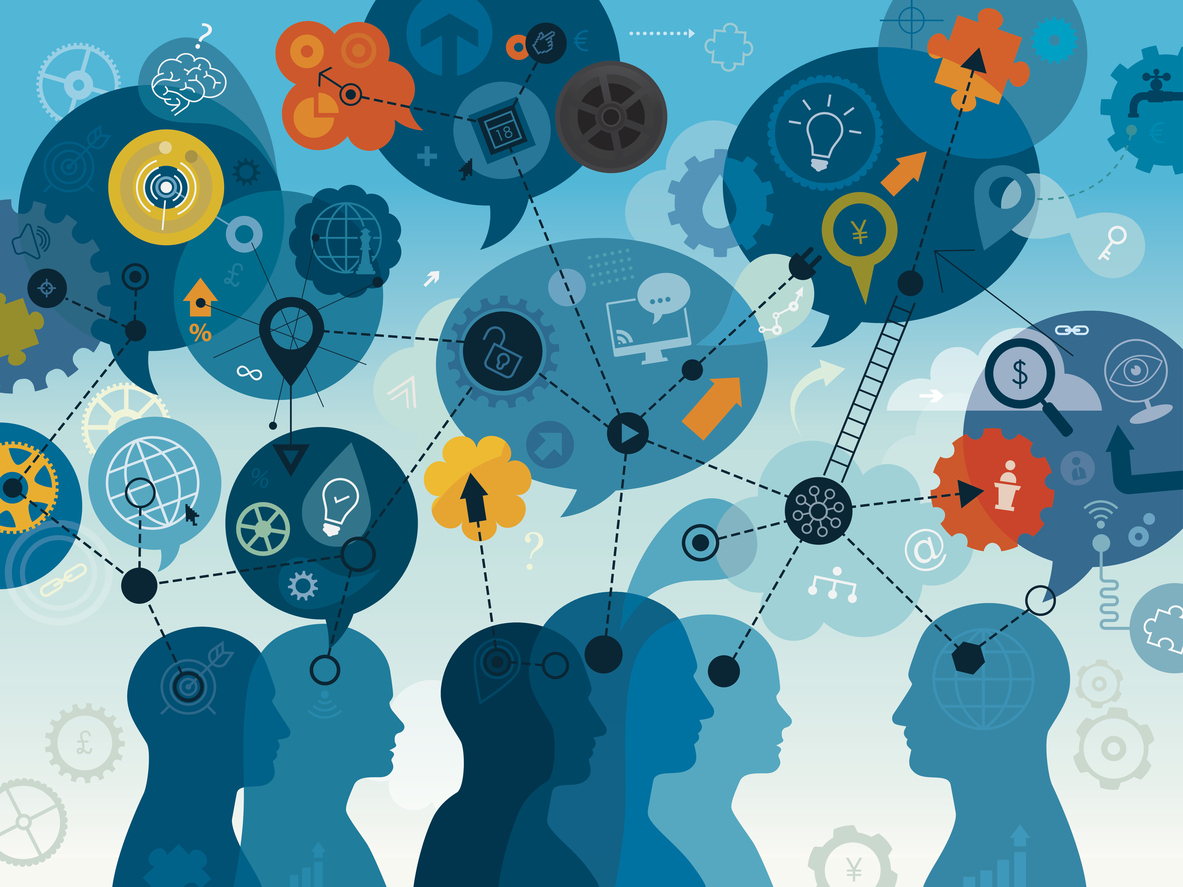
Digital Briefing Center: Intelligent Automation
Your guide to the future of AI-driven government innovation
“I believe,” said Alan Turing in 1950, “that at the end of the century the use of words and general educated opinion will have altered so much that one will be able to speak of machines thinking without expecting to be contradicted.” It’s 2017, and it seems that Turing's prophecy was right on the money. Artificial intelligence (AI) has inserted itself into virtually every single crevice of society — a development that holds dizzying economic and social implications. Welcome to Government Business Council’s Intelligent Automation Digital Briefing Center, where we’ll explore how federal, state, and local organizations are harnessing AI-driven automation to achieve new heights in efficiency, productivity, and citizen service.
Feel free to scroll through the page or use the navigation bar at the top to jump to a specific topic. Content will be updated on a continual basis.

Briefing #1

Notes on the Future
Renowned social scientist Herbert A. Simon was consulting at the RAND Corporation in the early 1950s when he first saw it: a printer using ordinary letters and punctuation to generate a map. For Simon, the significance of computer technology capable of handling non-numerical information was stunning: a machine that could manipulate symbols was a short step away from mimicking decision making processes — from simulating human thought.
The fallout of this revelation would mark, in many ways, the birth of modern AI. By 1956, Simon, along with scientists Allen Newell and Cliff Shaw, had created Logic Theorist: a computer program capable of proving mathematical theorems. Logic Theorist found new, elegant proofs for 38 of the first 52 theorems in Principia Mathematica — one of the first cases of a program broaching, albeit limitedly, the realm of abstract reasoning.
For Simon and Newell, AI’s march into our future was inevitable, and while some of their expectations may have been over-optimistic (Simon predicted in 1957 that a computer would become world chess champion within a decade — an event that did not, in fact, come to pass until 1997), this conclusion seems more foregone than ever. These days, AIs are beating us at Go, driving cars, engaging with autistic children, developing new drugs; advances are being made at vertiginous rates, unveiling a previously unimaginable realm of potential.
None of this is lost on the public sector. As evidenced by several early use cases, federal, state, and local organizations are increasingly invested in exploring and leveraging the power of intelligent automation:
- The Office of Personnel Management (OPM) is conducting a pilot program to incorporate automated social media tracking into background investigations.
- The North Carolina Innovation Center is experimenting with chatbots that can provide basic IT assistance to employees and citizens, freeing up help center agents to tackle more challenging tasks.
- The San Diego County Health and Human Services Agency has automated verification processes for eligibility applications, paving the way for enhanced accuracy and efficiency.
All of this is just the beginning. It’s a brave new world out there — and for government, the possibilities are endless.

Briefing #2

Meet Your New Co-Workers
It’s May 1997, and World Chess Champion Garry Kasparov has just been defeated in the match of the century. His opponent? Deep Blue, a supercomputer developed by IBM. For many, the match represents a pivotal existential shift: a new world order dominated by machines.
But is it necessarily a zero-sum game? In 2005, Playchess.com hosted a freestyle chess tournament which permitted human-computer partnerships. The initial results seemed to confirm predictions: grandmasters aided even by relatively weak computers were able to defeat supercomputer adversaries. The outcome of the final match, however, was so unexpected that many debated its validity. It wasn’t some grandmaster-supercomputer dream pairing that emerged victorious, but ZackS — a wild-card team comprised of two modestly-rated amateurs and three laptops. By successfully working with and “coaching” their computers to explore and analyze positions, the two were able to surpass both superior chess skill and more powerful computing capabilities.
What this means is that the man-versus-machine framework is intrinsically flawed: the strongest processes, the most beautiful solutions, emerge when humans and computers collaborate.
So, yes, AI will have a hand in our future — and that could be a good thing. Intelligent automation can radically bolster productivity, quality, and accuracy; it also addresses something Henry Ford famously lamented: “Why is it every time I ask for a pair of hands, they come with a brain attached?” Humankind’s greatest natural resources — creativity, abstract thinking, insatiable innovativeness — often go to waste in the face of menial, time-consuming tasks. Automating these activities can reshape human labor into something more meaningful, empowering workers to redirect their brainpower to higher-value, more stimulating objectives: advancing mission, enhancing customer service, and beyond.
This idea is taking root across government. The General Services Administration’s (GSA) 18F is using a Slack bot named Mrs. Landingham (after, yes, President Bartlet’s secretary in The West Wing) to assist in the onboarding process. Mrs. Landingham helps new hires fill out forms, decode government jargon, and participate in discussions; incoming messages are automated and staggered so as to not overwhelm employees with information. Best of all, her code is open source, making it available for anyone who might want to build their own Mrs. Landingham.
It’s all in a day’s work for government — and with AI in the office, the work is just that much easier.

Briefing #3

AI for the People
It’s sometimes easy, when hacking through a thicket of bureaucratic red tape, to lose sight of the true purpose of government: serving the people. Luckily, the advent of AI and intelligent automation has unlocked new possibilities for bolstering the citizen experience — and the results are speaking for themselves.
Let’s start with the small stuff: bots. These simplest of robots are being increasingly integrated into government agencies, where they’ve proven extremely effective in giving outdated processes a much-needed shot of adrenaline. For example, rather than leaving collected citizen data scattered across multiple agencies, bots can aggregate that information in a single interface. Citizens are provided with an updated, 360-degree view of their personal records, streamlining transactions such as filing taxes, applying for a driver’s licence, and registering a new business.
But AI’s ability to serve isn’t limited to improving customer service — as an October 2016 White House report notes, it has the potential to “solve some of the world’s greatest challenges and inefficiencies.” That potential is being fulfilled in fields and sectors across the board:
- The Department of Veterans Affairs is employing AI at Walter Reed National Military Medical Center to predict medical complications and make data-driven decisions around treatment — an initiative that has yielded better patient outcomes, enhanced surgical accuracy, and reduced health care costs.
- University of Chicago researchers used machine learning to create an early warning system for the Charlotte-Mecklenburg Police Department in North Carolina. Their algorithm, which relies on data collected by the White House’s Police Data Initiative, is able to identify officers who may be at risk of engaging in racial profiling, deadly shootings, and other harmful interactions, providing police departments with a potent weapon against police misconduct.
- AI isn’t just for the people: Dr. Milind Tambe and his team of University of Southern California researchers developed a program that uses AI modeling to predict poaching behavior. Protection Assistant for Wildlife Security (PAWS) takes data on previous poaching activities and generates routes for ranger patrols based on where poaching is more likely to occur; it also randomizes these routes to prevent poachers from learning patrol schedules. Systems like PAWS are injecting new energy into wildlife conservation efforts, showcasing the beauty of AI done right: as Dr. Tambe puts it, “It’s very easy for us just to do theory and mathematical models and be seduced by that…but seeing these places in person had the subtle impact of saying that we should protect this and not let it disappear off the face of the Earth.”
To learn more about how AI is being leveraged for the social good, check out former U.S. Chief Technology Officer Megan Smith’s speech at the 2016 Global Entrepreneurship Summit.
Brought to you by

The decision to automate can seem overwhelming. Any given organization has a multitude of areas that could benefit from automation, and deciding where to begin can be a challenge in itself. However, a number of methods can help government leaders navigate the process more efficiently.
Start small. There’s no need to automate your most complex tasks overnight. Kicking the process off with a small pilot program can demonstrate the value of automation while keeping any issues siloed from the larger organization. Robotic process automation (RPA) tools are affordable and offer significant ways to improve performance and reduce the burden of back-office operations. Pick a process to automate, develop a proof of concept utilizing the right tools for the job, and then scale it to the larger organization.
Involve the right people. Champions of automation will look for ways to improve their organization’s culture. Taking a people-first approach can ensure that the changes are serving you and your peers, building internal consensus as to the value of the program. Include all appropriate business and technology stakeholders, and make sure that plans and a governance model are clearly articulated to the organization at large.
Plan ahead — your peers are. The Department of Transportation has announced plans to establish an advisory committee on automation in preparation for the automated vehicles of the future. The Department of Homeland Security’s Customs and Immigrations Services already employs a neuro-linguistic programming (NLP) virtual assistant named EMMA that fields up to 500,000 citizen inquiries each month. These are just a handful of the agencies currently laying the groundwork for unleashing automation; the agency of the future will be the one that has anticipated and strategically integrated automation as a fact of life, employing it as a lever to improve mission delivery and the citizen experience.

Briefing #4

AI and the Labor Force
The last few posts have outlined many of the possible benefits of AI-driven automation, but here’s the thing: technology isn’t intrinsically good or bad. It’s pure, unstructured potential; what we do with it — and the consequences of those choices — reveals who we are, and where we’re going. Our technology begins and ends with us.
That’s why it’s critical, even as we maintain our optimism, to approach AI with care. Whether automation’s disruptive impact is ultimately for the better or worse hinges on the decisions we make right now — so with that in mind, here are a few strategies policymakers might consider when seeking to create a future that thrives on AI:
- Invest in AI development. We can expect some extraordinary technological breakthroughs in the next few years — but only if the public and private sectors continue to prioritize AI research and development. This means investing not just money, but people: in order to prevent algorithmic bias, the AI community needs to actively encourage participation from skilled personnel of all backgrounds. In addition, implementing pro-competition policies could also help catalyze exciting new developments in the field.
- Prepare workers for a 21st century labor market. AI is here for the long haul, and it is crucial that workers have the skills and education necessary to thrive in a rapidly shifting labor market. In order to do that, we have to start from the beginning: America must invest heavily in K-12 education in addition to ensuring that all students have access to affordable post-secondary education. Workers must also be provided with expanded training and guidance in order to weather possible job transitions.
- Strengthen economic and social safeguards. A country’s innovativeness and prosperity rest on empowered workers, and it’s up to policymakers to make sure job seekers are in a position to pursue the opportunities for which they’re most qualified. Moving forward in an AI world, the U.S. should bolster supports such as unemployment insurance, health care access, and worker bargaining power; it must also implement new social programs, including wage insurance and emergency aid for families in crisis. Modernizing the social safety net is essential toward assuaging concerns related to potential AI-driven job displacements.
Technology might be moving forward, but that doesn’t mean we have to leave people behind. By approaching new developments with respect and forethought, we can set ourselves up for a truly brave new world — one where progress and human welfare go hand-in-hand.

Briefing #5

AI on the World Stage
“The age of nations is past,” wrote Pierre Teilhard de Chardin in 1965. “It remains for us now, if we do not wish to perish, to set aside the ancient prejudices and build the Earth.” Over half a century of dizzying technological advancements later, his exhortation is more poignant and pressing than ever. The fact is, there is no historical precedent for a development like AI, and if we’re going to successfully cross that bridge, we need to do it together.
As U.S. policymakers continue to assess the socio-economic implications of AI, it is vital that they collaborate with foreign governments, international organizations, and other key stakeholders. Open dialogue and information exchange are key to identifying opportunities and gaps, accelerating progress, and crafting sound policies — and America, as a leader in AI R&D, has a pivotal role to play in the establishment of a responsible global framework. In this capacity, the U.S. has engaged in bilateral and multilateral discourse regarding international AI issues; the topic has been raised at the UN, G-7, Organization for Economic Cooperation and Development (OECD), and Asia-Pacific Economic Cooperation (APEC). These discussions will no doubt happen with increasing frequency in the years to come, potentially paving the way to global breakthroughs in health, climate change, social welfare, and more.
Of course, Teilhard de Chardin’s dream of large-scale international cooperation is difficult to achieve — but that doesn’t mean it’s out of reach. After all, as philosopher Nick Bostrom notes, “We’ve already come most of the way — from hunter-gatherer band, to chiefdom, to city-state, to nation-state, to the present mesh of states and international institutions. One more hop and we are there.”

Briefing #6
“We are ingesting petabytes of data every day, and we want to extrapolate from that to save lives,” says Todd Simpson, Chief Information Officer at the Food and Drug Administration (FDA).
Speaking at the 2017 Government Intelligent Automation Forum in Washington, D.C., Simpson and a panel of other government leaders sought to illustrate why automation is the solution to agencies’ big data problems.
For Justin Herman, a fellow panelist and Project Lead of GSA’s Technology Transformation Service, intelligent automation is finally addressing a headache he’s battled since first entering public service in 2012: “We had so much data, and there was so much we were leaving on the table. I guarantee you, there’s not an employee who goes home and doesn’t have the thought that we could’ve done more if only we’d made better use of all that data.”
He’s absolutely right. According to a 2016 study, over 90 percent of the world’s data was created in just the past two years, but only 1 percent of that data has actually been analyzed. And surprise, surprise: the U.S. government constitutes one of the largest repositories of data. Efforts to catalogue and consolidate this information have already resulted in close to 200,000 data sets being uploaded to data.gov — possibly just a fraction of the total amount waiting to be harnessed by agencies like FDA and GSA.
For agencies drowning in data, automation can be a life raft. By taking transactional, rules-driven tasks out of human hands, robotics process automation enables employees to devote more time to work that truly matters. Meanwhile, breakthroughs in natural language processing and pattern recognition now allow chatbots to identify repetitive tasks and ask users if they would like such tasks to be automated. And, as Simpson pointed out, advancements in analytics and cognitive automation are saving lives: by examining population health data, government researchers are better understanding the factors leading to childhood obesity, congenital heart disease, and poverty — and taking steps to improve the lives of those most vulnerable to these afflictions.
Dan Hoffman, Assistant City Manager of Gainesville, Florida, wants others to see this as automation’s true value: its ability to deliver savings and optimize business processes is a plus, but what’s most important are the citizens.
"Automation is starting to actually allow people live happier lives," he says. "Every step in the process should have some value; every action should help someone out.”

About Government Business Council
As Government Executive Media Group's research division, Government Business Council (GBC) is dedicated to advancing the business of government through analysis, insight and analytical independence. An extension of Government Executive's 40 years of exemplary editorial standards and commitment to the highest ethical values, GBC studies influential decision makers from across the federal government to produce intelligence-based research and analysis. www.govexec.com/insights
Report Author: Rina Li
About KPMG LLP
KPMG LLP is a recognized pioneer in intelligent automation. Governments need a partner that can help integrate the technology with existing business processes and systems in order to realize the many benefits of intelligent automation. Our knowledge of functional use cases combined with our deep public sector experience enables us to advise organizations at each stage of their intelligent automation journey. www.kpmg.com/us/federal